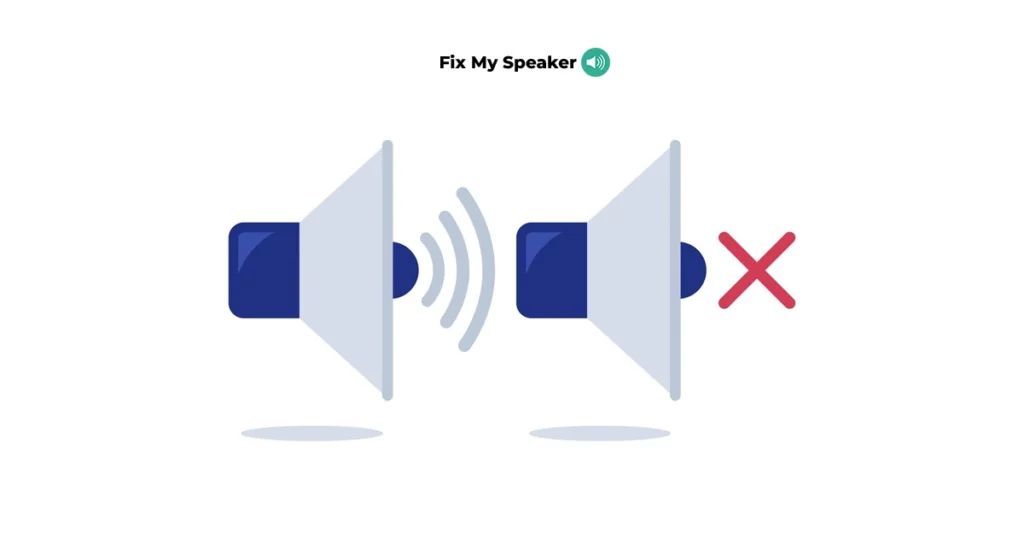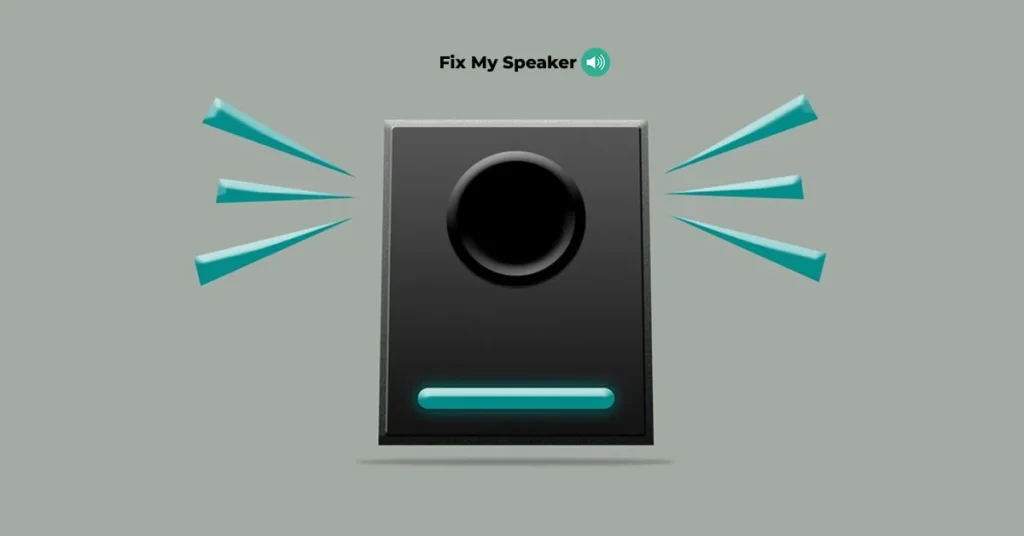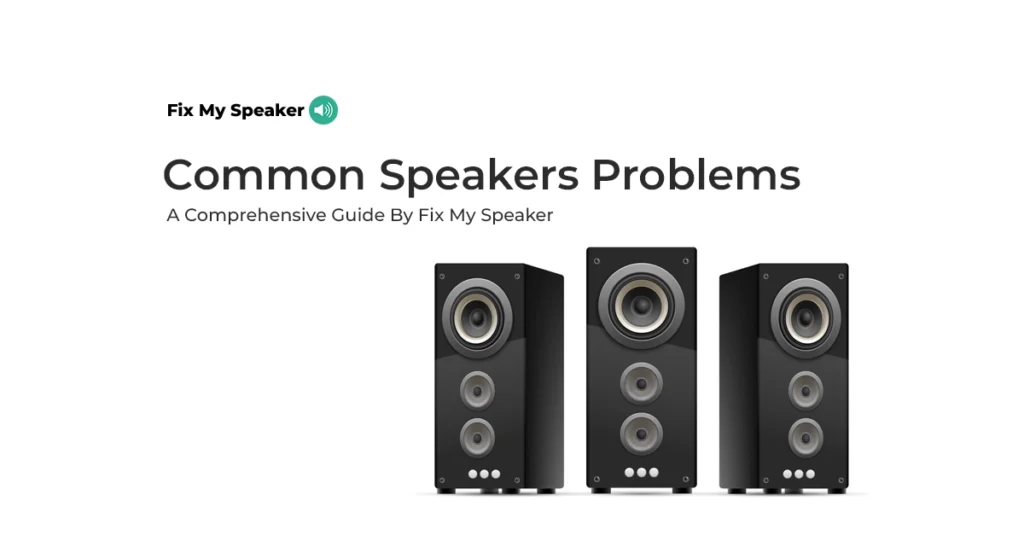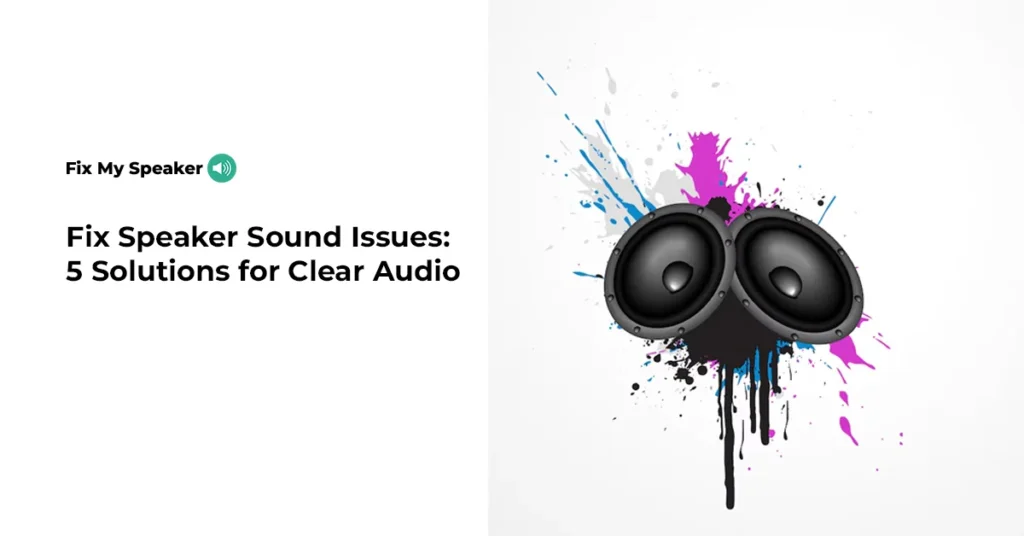In today’s digital age, our devices have become integral to both work and entertainment. Whether you’re trying to enjoy your favorite music, participate in an important video call, or immerse yourself in a gripping movie, clear and crisp audio is essential. However, audio output issues can quickly turn these experiences from enjoyable to frustrating. These problems range from complete silence to distorted sound quality, impacting not only our entertainment but also our productivity and communication. Understanding and resolving these issues is crucial for maintaining a seamless audio experience across our devices.
If you're experiencing issues with your audio setup, whether it's no sound, one speaker not working, low volume, or no bass response, our comprehensive guide on speaker problems can help. For an all-in-one solution, check out our Fix My Speaker tool. This tool offers step-by-step instructions and expert tips to diagnose and resolve common speaker issues, ensuring you get the best sound quality from your speakers.
Why is There No Sound Coming from My Speaker?

What is it?
One of the most common and perplexing audio problems is when no sound comes from the speaker, despite your device seemingly playing audio. This issue manifests as complete silence from your speakers or headphones, even when you’re certain that audio should be playing. It can occur on various devices, including computers, smartphones, and standalone speaker systems, leaving users puzzled and often scrambling for solutions.
What are the Causes?
Several factors can contribute to the absence of sound from speakers. Let’s explore the most common causes:
Disconnected or Loose Cables:
Physical connection issues are often the culprit behind silent speakers. In many cases, audio cables can become loose or disconnected over time due to movement or wear and tear. This is particularly common with external speakers or audio systems that rely on multiple cable connections. Even a slightly dislodged cable can interrupt the audio signal, resulting in no sound output.
Muted Audio Settings:
In our increasingly complex digital environments, it’s easy to overlook simple software settings. Many devices have multiple layers of volume control, including system-wide settings, application-specific volumes, and even individual audio track adjustments. If any of these are muted or set to a very low volume, it can result in no audible output, even if everything else is functioning correctly.
Faulty Speaker Hardware:
Sometimes, the issue lies within the speaker hardware itself. Speakers, like any electronic device, can malfunction due to various reasons such as:
– Physical damage from impacts or water exposure
– Wear and tear on internal components
– Manufacturing defects
– Electrical issues causing component failure
A faulty speaker may not produce any sound at all, even when receiving a proper audio signal.
Driver Issues:
Audio drivers act as a crucial bridge between your device’s hardware and software. When these drivers become outdated, corrupted, or incompatible with your system, it can lead to various audio problems, including complete sound loss. This is particularly common after operating system updates or when new hardware is installed without proper driver support.
What is the Fix?
Fortunately, many audio output issues can be resolved with some troubleshooting. Here are step-by-step solutions to address the most common causes:
Check and Reconnect Cables:
1. Identify all audio cables connected to your device and speakers.
2. Carefully unplug each cable, checking for any visible damage or debris in the ports.
3. Clean the ports gently with a dry, soft cloth if necessary.
4. Firmly reconnect each cable, ensuring they’re fully inserted into the correct ports.
5. If using a multi-part audio system, double-check that each component is properly connected.
Adjust Audio Settings:
1. Locate the volume icon in your device’s system tray or settings menu.
2. Ensure the system volume is not muted and is set to an audible level.
3. Open the sound settings to check for any disabled devices or incorrect default audio output selections.
4. In Windows, right-click the volume icon and select “Open Sound settings” for more detailed options.
5. On Mac, go to System Preferences > Sound to adjust output settings.
6. Check individual applications for their specific volume controls and mute settings.
Test Speaker with Another Device:
1. Disconnect the speaker from the current device.
2. Connect it to another device, such as a smartphone or different computer.
3. Play audio on this second device to determine if sound is produced.
4. If the speaker works with the second device, the issue likely lies with the original device’s settings or hardware.
5. If no sound is produced on multiple devices, the speaker itself may be faulty.
Update or Reinstall Audio Drivers:
1. For Windows:
– Open Device Manager (right-click Start button > Device Manager)
– Expand the “Sound, video and game controllers” section
– Right-click on your audio device and select “Update driver”
– Choose to search automatically for updated driver software
2. For Mac:
– Apple generally handles driver updates through system updates
– Go to Apple menu > System Preferences > Software Update
– Install any available updates
3. If updating doesn’t work, try uninstalling the driver:
– In Device Manager, right-click the audio device and select “Uninstall device”
– Restart your computer, which should automatically reinstall a generic audio driver
4. If issues persist, visit the manufacturer’s website to download and install the latest audio drivers manually
By methodically working through these solutions, you can often resolve the issue of no sound from your speakers. Remember, if these steps don’t solve the problem, it may indicate a more serious hardware issue that requires professional repair or replacement of your audio equipment.
Why is Only One Speaker Working in My Setup?
What is it?
In a multi-speaker setup, whether it’s a stereo pair, surround sound system, or even headphones, encountering a situation where only one speaker produces sound can be frustrating. This issue manifests as audio coming from one side or channel while the other remains silent. It’s a common problem that can significantly impact the audio experience, disrupting the stereo effect or surround sound immersion that multi-speaker setups are designed to provide.
What are the Causes?
Several factors can lead to one speaker not working in a multi-speaker system. Let’s explore the most common causes:
Balance Settings:
Audio balance settings control the distribution of sound between left and right channels. If these settings are improperly adjusted, they can cause one speaker to be significantly louder than the other or even mute one side entirely. This is often overlooked but can be a simple cause of apparent speaker failure. Modern operating systems and audio software typically include balance controls that, if accidentally adjusted, can create the illusion of a non-functioning speaker.
Cable or Connector Issues:
Physical connections are crucial for proper audio transmission. In multi-speaker setups, each speaker typically has its own cable or connection point. Issues with these can include:
– Loose connections where the cable is not fully inserted into the port
– Damaged cables with internal wire breaks
– Corroded or dirty connectors that impede signal transmission
– Bent or broken pins in the connectors
Even a slight issue in the physical connection can result in one speaker failing to receive the audio signal, leading to silence from that unit.
Speaker Damage:
Physical damage to a speaker can cause it to stop functioning. This damage can occur due to various reasons:
– Accidental impacts or drops
– Exposure to extreme temperatures or humidity
– Age-related wear and tear on internal components
– Manufacturing defects that manifest over time
– Electrical surges damaging the speaker’s circuitry
A damaged speaker may not produce any sound at all, even when receiving a proper audio signal, resulting in the one-speaker-not-working scenario.
Audio Source Issues:
Sometimes, the problem lies not with the speakers or connections but with the audio source itself. This can include:
– Faulty audio files that only contain one channel of audio
– Incorrectly configured software that’s not outputting to all channels
– Hardware issues with the audio output device (e.g., sound card problems)
– Incompatibility between the audio source and the speaker system
What is the Fix?
Addressing the issue of one speaker not working involves systematically checking and correcting potential causes. Here are detailed steps to resolve the problem:
Adjust Balance Settings:
1. On Windows:
– Right-click the speaker icon in the taskbar and select “Open Sound settings”
– Click on “Device properties” under the output section
– Select “Additional device properties”
– Go to the “Levels” tab and click “Balance”
– Ensure both left and right channels are set to the same level
2. On Mac:
– Go to Apple menu > System Preferences > Sound
– Click the “Output” tab
– Adjust the “Balance” slider to the center position
Inspect and Replace Cables:
1. Visually inspect all audio cables for signs of damage, kinks, or fraying.
2. Unplug and firmly replug each cable, ensuring a secure connection.
3. If possible, test the system with known good cables to isolate cable issues.
4. For wireless speakers, check the Bluetooth or Wi-Fi connection and try re-pairing.
5. If a cable is suspected to be faulty, replace it with a new one of similar quality.
Test with a Different Audio Source:
1. Try playing audio from a different device (e.g., smartphone, another computer).
2. Use various audio files or streaming services to rule out source-specific issues.
3. If possible, test with different audio software or media players.
4. Check if the issue persists across all applications or is limited to specific ones.
5. If the problem only occurs with one source, investigate that source’s audio settings or try reinstalling the audio software.
Check for Physical Damage:
1. Visually inspect each speaker for signs of physical damage.
2. Look for any tears in the speaker cone, dents in the housing, or signs of water damage.
3. Gently press on the speaker cone to feel for any unusual resistance or sounds.
4. For powered speakers, ensure all power connections are secure and the unit is receiving power.
5. If damage is found, consider professional repair or replacement, especially for high-end systems.
Additional Tips:
– Try swapping the left and right speaker connections to see if the problem follows the speaker or stays with the channel.
– For computer systems, updating or reinstalling audio drivers can sometimes resolve channel-specific issues.
– In some cases, resetting the audio device to factory settings (if available) can clear up configuration problems.
Why is the Volume So Low on My Speakers?

What is it?
Low volume is a common audio issue where the sound output from your device or speaker system is significantly lower than expected, even when volume controls are set to maximum levels. This problem can manifest as audio that’s barely audible, requiring listeners to strain to hear content, or as sound that lacks the power and clarity typically associated with normal volume levels. Low volume issues can severely impact the enjoyment of music, the clarity of voice calls, or the immersive experience of movies and games.
What are the Causes?
Several factors can contribute to low volume issues. Let’s explore the most common causes:
Volume Settings:
One of the primary causes of low volume is incorrectly configured volume settings. This can occur at multiple levels:
– System-wide volume settings that control overall audio output
– Application-specific volume controls that may be set low independently of system volume
– Individual audio track or media file volume levels
– Output device settings that might be limiting volume
Weak Audio Signal:
A weak audio signal from the source can result in low volume, even when playback devices are functioning correctly. This can be due to:
– Low-quality audio files or streams with inherently low volume levels
– Improperly configured audio output settings on the source device
– Interference or signal degradation in the audio transmission path
– Mismatched impedance between the audio source and playback device
Speaker Power Issues:
For powered speakers or audio systems, inadequate power supply can lead to low volume:
– Loose or faulty power connections
– Weak batteries in portable speakers
– Inadequate power supply units that can’t deliver enough current
– Power-saving modes that limit audio output to conserve energy
Audio Enhancements:
Paradoxically, certain audio enhancement features designed to improve sound quality can sometimes result in reduced volume:
– Equalizer settings that cut certain frequency ranges
– Dynamic range compression settings that limit peak volumes
– Spatial audio effects that may reduce overall volume to create perceived space
– Volume normalization features that lower the volume of louder tracks
What is the Fix?
Addressing low volume issues involves a systematic approach to check and adjust various settings and components. Here are detailed steps to resolve the problem:
Increase System and Application Volume:
1. Adjust System Volume:
– Windows: Click the speaker icon in the taskbar and drag the slider to maximum.
– Mac: Use the volume keys or click the volume icon in the menu bar.
– Mobile devices: Use the physical volume buttons or swipe down for quick settings.
2. Check Application Volume:
– Look for in-app volume controls, often found in settings or as an overlay during media playback.
– Ensure the application isn’t muted or set to a low volume independently of system settings.
3. Verify Output Device Settings:
– Windows: Right-click the speaker icon > Open Sound settings > Device properties > Additional device properties > Levels tab
– Mac: Apple menu > System Preferences > Sound > Output tab
Here’s a table summarizing key volume settings to check:
| Setting Type | Windows Location | Mac Location | Mobile Location |
| System Volume | Taskbar speaker icon | Menu bar volume icon | Physical buttons / Quick settings |
| App Volume | In-app settings | In-app settings | In-app settings |
| Output Device | Sound settings | System Preferences > Sound | Settings > Sound |
Check Audio Source Quality:
1. Try different audio files or streams to rule out issues with specific content.
2. Ensure you’re using high-quality audio files (e.g., 320kbps MP3 or lossless formats).
3. For streaming services, check your quality settings and try increasing them if possible.
4. Verify that any audio processing software or plugins aren’t reducing the signal strength.
Ensure Proper Power Supply:
1. For wired powered speakers:
– Check that the power cable is securely connected.
– Try a different power outlet to rule out electrical issues.
– If applicable, ensure the correct voltage setting is selected on the speaker.
2. For battery-powered speakers:
– Check battery levels and replace or recharge if necessary.
– Some speakers reduce volume when battery is low; try operating while plugged in.
3. For passive speakers:
– Ensure the amplifier is powerful enough for the speakers.
– Check all connections between the amplifier and speakers.
Disable Audio Enhancements:
1. On Windows:
– Right-click the speaker icon > Open Sound settings > Device properties > Additional device properties
– Go to the “Enhancements” tab
– Check the box for “Disable all sound effects”
2. On Mac:
– Apple menu > System Preferences > Sound > Output
– Uncheck any audio enhancement features like “Use ambient noise reduction”
3. In media players and apps:
– Look for equalizer settings and try setting them to flat or off
– Disable any audio effects or enhancements within the application settings
Additional Tips:
– Update audio drivers to ensure compatibility and optimal performance.
– Check for any physical obstructions or damage to speaker cones that might impede sound output.
– For Bluetooth speakers, ensure they’re within proper range and try re-pairing the device.
Why is There No Bass Response in My Audio Output?

What is it?
No bass response refers to a situation where audio output lacks low-frequency sounds, typically ranging from 20 Hz to 250 Hz. This results in a thin or tinny sound quality, devoid of depth and richness. Without proper bass, music loses its fullness, movie explosions lack impact, and even voices can sound unnaturally thin. This issue significantly diminishes the immersive quality of audio experiences across various media.
What are the Causes?
Incorrect Equalizer Settings
Equalizer settings play a crucial role in shaping audio output. When low-frequency bands are set too low or high-frequency presets are selected, it can lead to a noticeable lack of bass. Users might inadvertently apply settings that cut bass frequencies in an attempt to reduce distortion or increase clarity, not realizing the impact on overall sound balance.
Speaker Positioning
The placement of speakers significantly affects bass response. Bass frequencies are omnidirectional but prone to interference from nearby surfaces. Improper positioning can create phase cancellations or standing waves, diminishing bass output. Conversely, placing speakers in very large, open spaces can cause bass frequencies to dissipate before effectively reaching the listener.
Faulty Subwoofer
In many audio setups, especially home theater systems, a dedicated subwoofer handles the lowest frequencies. Malfunctions in this component can lead to a complete lack of bass response. Issues may range from physical damage to the speaker cone to electrical problems within the subwoofer’s amplifier. Sometimes, improper connections between the subwoofer and the main audio system prevent bass signals from reaching the subwoofer altogether.
Audio Source Quality
The quality of the audio source itself can significantly impact bass response. Low-bitrate audio files or poor-quality streams often sacrifice low-frequency information to reduce file size. This compression can strip away much of the bass content, resulting in thin-sounding audio even on high-quality playback systems.
What is the Fix?
Adjust Equalizer Settings
Start by resetting your equalizer to a flat or neutral setting. Gradually increase the levels of the lower frequency bands, typically those below 250 Hz. Be cautious not to overdo it, as excessive bass can lead to distortion. Many devices offer preset EQ settings; try the “Bass Boost” or “Rock” presets as starting points, then fine-tune to your preference.
Recommended Equalizer Adjustments for Enhanced Bass
| Frequency Range | Adjustment |
| 20-60 Hz | +2 to +4 dB |
| 60-120 Hz | +1 to +3 dB |
| 120-250 Hz | 0 to +2 dB |
| Above 250 Hz | 0 dB (flat) |
Reposition Speakers
Experiment with speaker placement to optimize bass response. As a general rule, position speakers about 2-3 feet away from walls and corners. This distance helps prevent excessive bass buildup while still allowing for some reinforcement from nearby surfaces. For optimal stereo imaging and bass response, form an equilateral triangle between your listening position and the two main speakers.
Optimal Speaker Positioning Guidelines
| Speaker Type | Distance from Wall | Distance from Corner | Angle to Listener |
| Main Speakers | 2-3 feet | 3-4 feet | 22-30 degrees |
| Subwoofer | 4-6 inches | In corner or 1/3 along wall | N/A |
Test and Repair Subwoofer
First, ensure all connections to the subwoofer are secure and correctly configured. Check the subwoofer’s volume and crossover settings, adjusting them to match your main speakers’ capabilities. To test the subwoofer, play a bass-heavy track and place your hand gently on the cone to feel for vibration. If you detect no movement or hear distortion, the subwoofer may need repair or replacement.
Subwoofer Troubleshooting Steps
| Issue | Check | Potential Fix |
| No sound | Power, connections, volume | Secure connections, adjust volume |
| Distorted sound | Crossover frequency, volume | Lower volume, adjust crossover |
| Intermittent sound | Cable integrity, amplifier | Replace cables, check amplifier |
Use High-Quality Audio Sources
Opt for high-quality audio files or streams whenever possible. For digital music, choose lossless formats like FLAC or Apple Lossless, or high-bitrate MP3s (320kbps or higher). When streaming, select the highest quality setting available on your preferred platform.
Recommended Audio Source Quality
| Format | Minimum Bitrate | Ideal Bitrate |
| MP3 | 192 kbps | 320 kbps |
| AAC | 256 kbps | 320 kbps |
| FLAC | Lossless | Lossless |
| Streaming | “High Quality” setting | “Hi-Fi” or lossless tier |
Take Away
Addressing audio output issues, particularly the lack of bass response, is crucial for maintaining an optimal listening experience. By understanding the common causes and applying the appropriate fixes, you can often resolve these problems and restore your audio system to its full potential. Regular maintenance and periodic checks of your audio equipment can prevent many issues from arising in the first place.
Don’t hesitate to experiment with settings and configurations to find the optimal setup for your specific audio environment. If problems persist after trying these solutions, consider consulting with a professional audio technician who can provide more specialized diagnostics and repairs. With attention to detail and proper care, you can ensure that your audio system continues to deliver rich, full-bodied sound across all your entertainment needs.


